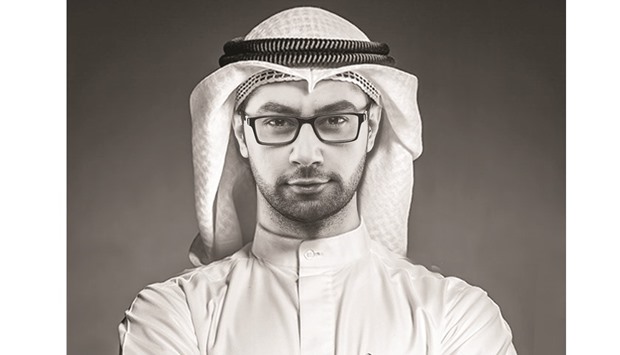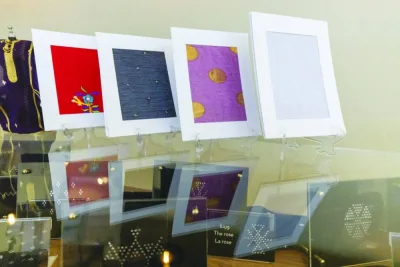His ideas will always be different yet contemporary. Monotony in the medium of his works simply disrupts his mind and hand co-ordination. Othman Khunji would put together various materials in a single concept to erect, in essence, a stimulating piece of art that triggers debate.
You pass by his ‘Crude Rise: A Qatari Journey’ piece on exhibition at ‘Strange Wonders’ one of these days and you would find yourself becoming part of the debate.
Strange Wonders is the recently inaugurated exhibition by the students and faculty of Virginia Commonwealth University (VCU) Qatar at Msheireb Museums.
“The concept behind this piece involves an object that is shaped like a building. It basically denotes a timeline, starting at the bottom with sand from Doha saying that Qatar used to be a desert,” Khunji, a Bahraini artist currently based in Doha.
He recently graduated from VCUQ with an MFA degree in Design studies and is now working at Qatar Museums as Exhibitions Design Production Specialist.
“And then there is water which takes shapes from a Qur’anic verse that says from water everything came to life. So from the desert that it was, water brought it to life until it reached the third potent state which is discovery of oil,” he elaborates.
And that stage actually shapes his building which is the idea of growth and progression. On the big installation, he has used the icon of the giraffe-neck to basically use it as an enabler. And finally, he stresses on one point that without the Qatari people and working hands, Qatar would not have been what it is today.
Khunji invites people to come and interact with it by themselves by holding the rig handle and pushing it down. When you do that, the rocks drop and go through the whole timeline and then you see the bubbles of the oil coming up.
“I am a Bahraini myself so as a Khaleeji, we have this idea of what we were before and what we are today. So it is just to highlight our childhood, who we were before and the simplicity of our lives,” says the artist.
“And today, this change with all this technology and this fast pace of our lifestyle, this piece gives that idea that yes we are going to all this, but at the end of the day as life changes from the desert to the water to the oil, we ourselves are playing our role by pushing down the rig,” he clarifies.
All his ideas even those in his previous exhibitions have been praised for their uniqueness and artistic value.
He says he gets his ideas from everyday life by interacting with people. “I am an extrovert. What I am doing with you right now, I do it with everyone. I talk to people. Most of what I create I like to think that it comes from the social justice perspective. I target issues that I am a part of and I am living in and the people are living in and I see what is going on and I try to highlight,” says the young artist.
“That is how I get my inspiration. I talk to people. I see what is bothering them, what is happening that might be wrong and overlooked and I try to create a kind of platform for debate,” says Khunji.
As he drifts away from the traditional artistic mediums, people often question him if is an artist. “I do not really have an answer,” says Khunji. But most people would tell him he probably is the inter-disciplinary designer and it makes sense, he acknowledges. Nevertheless, his pieces keep their artistic value intact.
Khunji says he likes to mix so many things. In this one piece, there is wood, metal, acrylic, sand, water, rocks, crude oil and other materials. The artist says he gets bored if it is one medium. And if he keeps going in that one medium in so many projects, he would lose interest.
“This is why my every piece has a very different concept, approach and medium. The ones that I made in Fire Station residency, they had in them marble, concrete, steel, etc. So I like to experiment. And I am not going to lie to you, it is not cheap to experiment,” says Khunji.
You have to work on all these small little elements in different workshops and then bring it together as one piece, it is very stressful, but it is worth it, he adds.
“In the end, when people look at it and say nice things and give constructive feedback that is the validation I need. It inspires me to go to the next piece,” says the artist.
He is open with the dimensions his pieces may take. They can be compact or free flowing. Sometimes he likes to use technology, but would keep them analog the other times.
His work ranges across the fields of interior, fashion, product, and interactive installation design. The social behaviours, from an Islamic perspective, triangulating how the relationships between religion, culture, and society can be expressed through the language of design are his particular areas of interest.
Whether educational or critical, evocative or reminiscent, his interactive creations invite a reawakening and exploration of faith-based practices and social justice issues that will establish platforms for dialogue in the hope of generating new schools of thought.
Khunji’s studies include his latest publication, RITUALS, Our Past, Present & Future: Glimpses of Islamic Enrichment and its accompanying collection, The Five Pillars of Islam, soon to be exhibited at The Museum of Islamic Art in Doha.
Living between, Bahrain, Dubai, Colombia and Qatar, Khunji has gained knowledge of various international languages of design. Additionally, his work has been showcased in Qatar at Katara and Doha Fire Station, in Dubai at Design Days and The Mine Gallery, and in Abu Dhabi at Zayed University Middle East Film Festival.
Khunji is designing the Bahraini pavilion at the Design Week Dubai which is happening from 24th to 29th of October besides coming up with a couple of other pieces, again connected to life, very soon.

DIFFERENT: Othman Khunji says he loves mixing different mediums in his installations.


